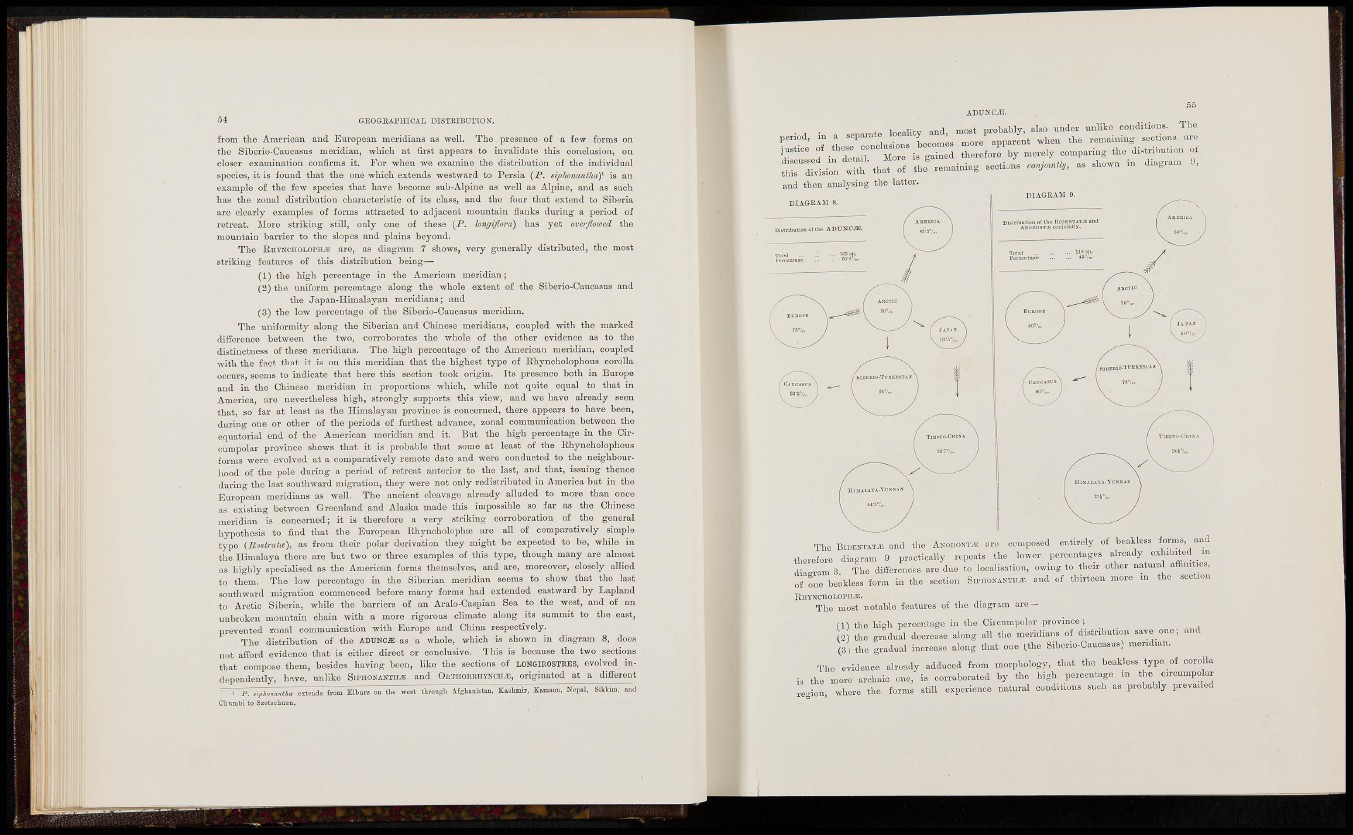
54 GEOGRAPHICAL DISTEIBUTIOÍÍ.
ADUNCiE.
from the American and European meridians as •well. The presence of a few forms on
the Siberio-Caucasus meridian, -which at €rst appears to invalidate this conclusion, on
closcr examination confirms it. For when we examine the distribution of the individual
species, it is found that the one which extends westward to Persia (P. siphonanthaf is aa
example of the few spccies that have become sub-Alpine as well as Alpine, and as such
has the zonal distribution characteristic of its class, and the four that extend to Siberia
are clearly examples of forms attracted to adjacent mountain flanks dm-ing a period of
retreat. More striking still, only one of these (P. longiflora) has yet overjloioad the
mountain barrier to the slopes and plains beyond.
The EnTNonoLOPH^ are, as diagram 7 shows, very generally distributed, the most
striking features of this distribution being—
(1) the high percentage in the American meridian;
(2) the uniform percentage along the whole extent of the Siberio-Caucasus and
the Japan-Himalayan meridians; and
(3) the low percentage of the Siberio-Caucasus meridian.
The uniformity along the Siberian and Chinese meridians, coupled with the marked
difference between the two, corroborates the whole of the other evidence as to the
distinctness of these meridians. The high percentage of the American meridian, coupled
with the fact that it is on this meridian that the highest type of Rhyncholophous corolla
occm-s, seems to indicate that here this section took origin. Its presence both in Europe
and in the Chinese meridian in proportions which, while not quite equal to that in
America, are nevertheless high, strongly supports this view, and we have already seen
that, so far at least as the Himalayan province is concerned, there appears to have been,
dm-ing one or other of the periods of furthest advance, zonal communication between the
equatorial end of the American meridian and it. But the high percentage in the Circumpolar
province shows that it is probable that some at least of the Ehyncholophous
forms were evolved at a comparatively remote date and were conducted to the neighbourhood
of the pole during a period of retreat anterior to the last, and that, issuing thence
during the last southward migration, they were not only redistributed in America but in the
European meridians as well. The ancient cleavage already alluded to more than once
as existing between Greenland and Alaska made this impossible so far as the Chinese
meridian is concerned; it is therefore a very striking corroboration of the general
hypothesis to find that the European Rhyncholopha^ are all of comparatively simple
type (Rostraicc), as from their polar derivation they might be expected to be, while in
the Himalaya there are but two or three examples of this type, though many are almost
as highly specialised as the American forras themselves, and are, moreover, closely allied
to them. The low percentage in the Siberian meridian seems to show that the last
southward migration commenced before many forms had extended eastward by Lapland
to Arctic Siberia, while the barriers of an Aralo-Caspian Sea to the west, and of an
unbroken mountain chain with a more rigorous climate along its summit to the east,
prevented zonal communication with Europe and China respectively.
The distribution of the ADONCa: as a whole, which is shown in diagram 8, does
not afford evidence that is either direct or conclusive. This is because the two sections
that compose them, besides having been, like the sections of LONGIROSTRES, evolved independently,
hwe, unlike SIPHOKANTHÍE and OKTHOEEEYNCHIE, originated at a different
. p. .iphcvantha estcuds from Elburz oa the west through Afghanistan, Kashmir, Kamaon, Nepal, Siklcim, and
Chnmbi to Szetschuan.
• , • „vnt.. locality and, most probably, also undoi unliko conclitiom. Tbe
• ^ T o o T L s t ' o t l on b3 om» „»../apparent the refining aeeuons are
f i tea r More is gained therefore by merely comparing the dwtnbut.on of
renaming sections as sl,o.n in dragram 9,
and then analysing the latter.
,] DIAGRAM 9.
DIAGRAM 8.
The BIDEN,™ and the ANODOXI.Ì .re composed entirely of beakless forms, and
therefore diagram 9 practically repeats the lower percentages already exlnbrtod n,
d I m 3 ihe differences are due to localisation, owing to their other natnra affin, .es,
of L e beakless term in the section SmiONiS-nui,^ and of thirteen more rn the section
RNYNCHOLOPEAI.
The most notable features of the diagram are-
(11 the high percentage in the Cirenmpobr province;
2 the gradaal decrease along all tl.e meridians of distribntion save one; and
(31 the gradual increase along that one (the Siberio-Oaucasus} meridian.
The evidence already adduced from morpholegv, that the heakless type of corolla
i , the mere archaic one, is corroborated by the high percentage in the eireampete
re-ion v,here the forms still experience natural conditions such as probably prevadea